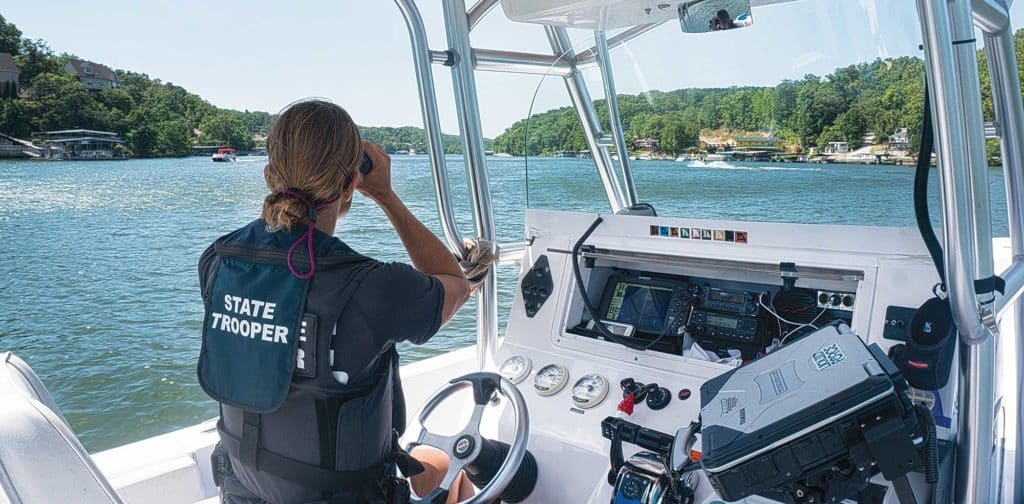
Almost every lake and bay has a party cove, but one body of water bursts into the brain when those words are uttered: Lake of the Ozarks, known by nontourists as LOTO for short.
Located halfway between St. Louis and Kansas City in central Missouri, LOTO is known to play host on any given July Saturday to hundreds, if not thousands, of boats rafted up in a mile-or-so-long cove, filling it from shore to shore in a spectacle that is … well, a spectacle.
Some have called this phenomenon legendary. Others have called it notorious. Among locals, it’s not popular and never made the tourism brochures. To get the lowdown on it, last summer we asked the Missouri State Highway Patrol if we could hitch a ride on the water. The commanding officers suggested I connect with Trooper Stacey Mosher, a 20-year veteran of lake law enforcement.
We made a date for a beautiful Saturday in July. It was peak tourism season and prime time for large gatherings in Anderson Hollow Cove, the party spot popularly known as Party Cove.
Last time I was in Party Cove, a good 15 years earlier, it was already buzzing by 10 a.m., full of houseboats, go-fasts, runabouts and cruisers. So, I was surprised when Mosher suggested we wait until afternoon.
“It’s different now,” Mosher said. “You’ll have to wait and see it.” I figured she wanted to get there about the time when things usually get out of hand.
We settled on a meeting time of 9:30 a.m. at the Moorings, about 2 miles from Party Cove and about 2 miles from the main arm of the lake, the Osage River.
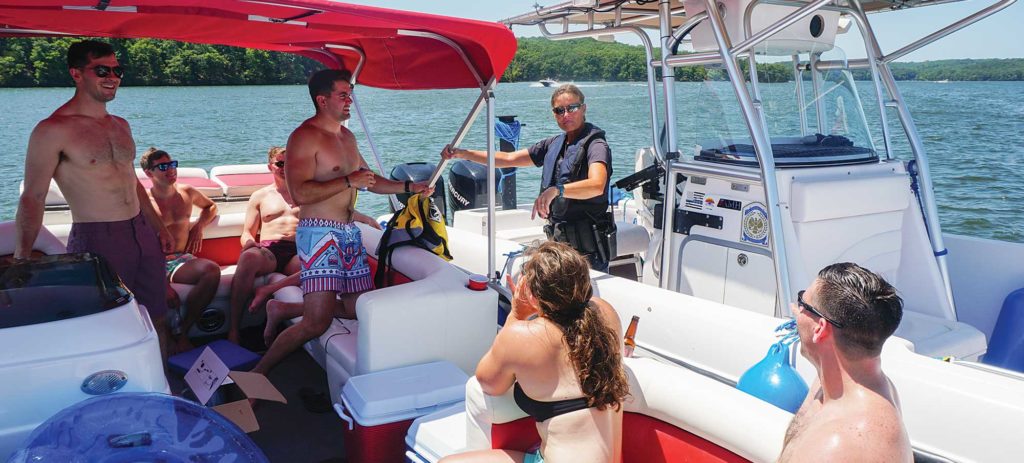
9:30 A.M.
Mosher welcomed me aboard the patrol boat, an aging but well-maintained Donzi center console, handed me a life jacket, and told me where to stow my lunch and drinks. We cast off, and Mosher headed downstream.
The Moorings is on the boundary of a 1.5-mile no-wake zone marked off to protect the shoreline of this narrow stretch of lake from the wakes of the boats that flood the upper reaches of the Grand Glaize Arm, seeking more solitude among its less developed banks — or its Party Cove. Near the boundary a few hundred yards out, Mosher aimed her patrol boat to a sistership idling offshore.
Both chalky Donzis were solid and probably rewired a dozen times since they were built decades ago. The twin Mercury 350s still purred despite the 2,600 hours on them. It’s the gear cases that take the brunt of LOTO patrol duty. The boats go through about two every season.
Today, Trooper Max Lawson would complete his training as a water patrolman. The two chatted awhile, exchanging their itineraries for the day. Then we crept through the remainder of the lengthy no-wake zone.
10 A.M.
Our first stop came right to us and at a high rate of speed, pushing a good wake. It was a pocket cruiser about 28 feet long, and the family on board was enjoying the breeze while increasing the throttle. No ticket here, just a verbal request to abide by the no-wake-zone requirements. Compliance was friendly; the crew seemed relieved.
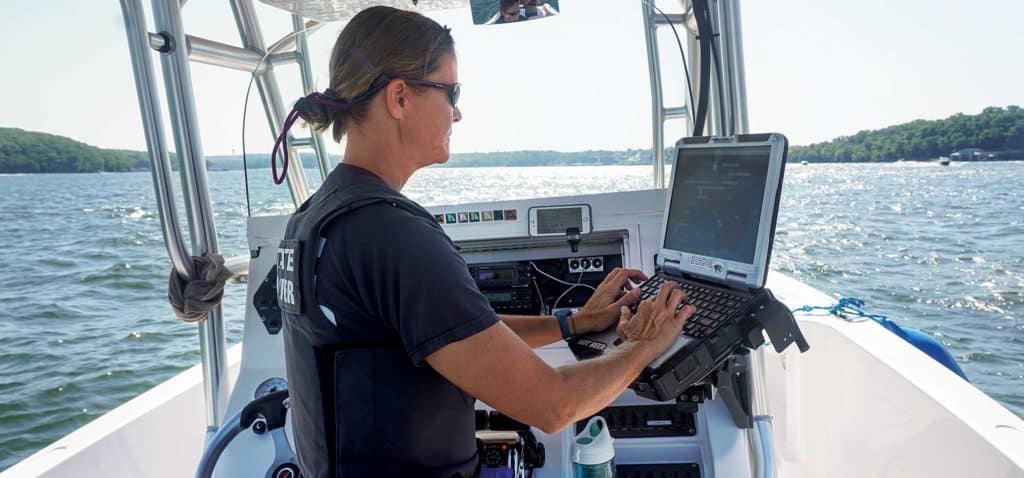
10:49 A.M.
Just out of the no-wake zone, we moved toward a pontoon sitting in the middle of the Osage Arm of the lake. I couldn’t see what they were doing wrong, so I waited while Mosher eased up to them.
“Do you see a skier down anywhere?” Mosher asked me.
“Not a thing.”
“Need any help?” she inquired of them.
“No, we are just waiting for a Jet Ski.”
“If you could take that flag down, I would appreciate it,” she implored.
“We were just trying to play safe for the Jet Ski.”
“You only display the flag for a skier or wakeboard rider, not personal watercraft or any other following vessel.”
Mosher inspected life jackets, then requested the skipper’s name and address, which she logged along with the violation into the laptop mounted at the helm. She was polite and friendly, but I could tell it burns her up. She’s a skier.
“The purpose is very specifically to warn people that a rider is down or coming along behind on a rope so they don’t cut him off,” she said. “So, if there is a next time, he’ll get a ticket.”
We’d barely jumped up on plane before another boat caught Mosher’s attention. It was an express cruiser, maybe a 40-footer, and perched on its transom seat, a good 6 feet over the swim platform, was a woman enjoying the ride. A single lurch could get her a ticket to the emergency room or, from that height, the morgue. Mosher signaled her to sit inside the boat. Clearly, the lady knew she was in the wrong.
Mosher wasn’t eager to write citations.
We left the cruiser behind and noticed a watercraft approach the pontoon, and we turned our attention to the surrounding traffic.
It seemed like a good time to ask what kind of personal boat she had.
“A 1995 Ski Ray, a Yamaha 1200 and some kayaks,” she said. They’d sold a pontoon and a Jet Ski, then indulged themselves with a wakeboard tower for the Ski Ray.
For fun, I asked her about her brand preferences. Her answer was more professional than recreational.
“I like the Yamaha WaveRunners. They have the jet spray in the back that goes straight up when they are running. That’s golden,” she said. “It’s like a brake light. It gives you a visual cue that the watercraft in front of you is slowing down.”
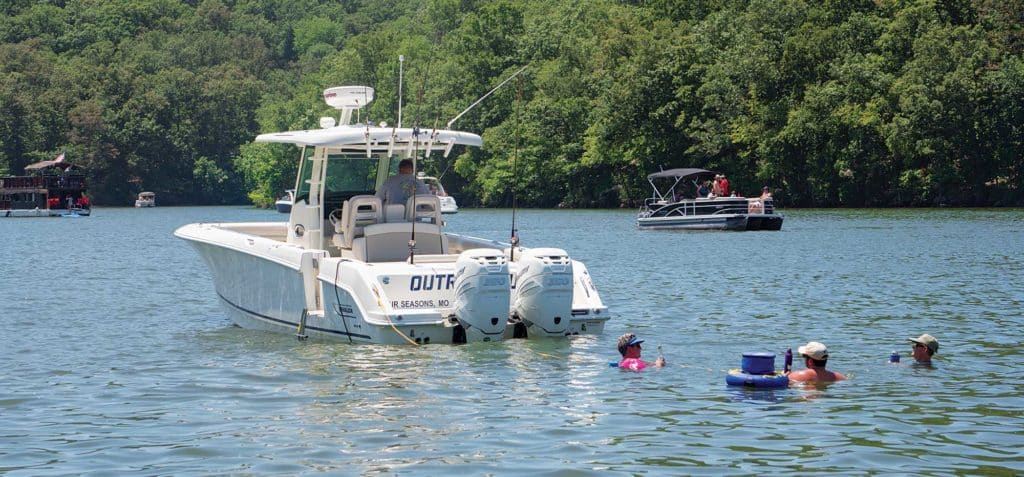
11:10 A.M.
Lake traffic for this July Saturday is still relatively light, but Mosher has no trouble finding boaters who just don’t know the rules. Soon another ski-flag waver darted out of a cove with no skier in tow. Mosher gave chase, turning and accelerating smoothly. By the time we caught up, the flag was gone. She didn’t even bother with a warning.
Then, 200 yards away, a teen boy throttled up a watercraft, carving a semidoughnut turn and doing so right off the dock. Worse yet, he was in a narrow finger of the cove with not 20 yards from that dock to the one on the other side.
Now, I thought, I’d finally witness a citation tendered. Mosher approached the teen, a young man, who gripped the gunwale of the Donzi, holding himself in place to take his medicine.
The doughnut-doer’s family eased up in a runabout, and Mosher waved in a friendly way. She was still all-marine with the boy and asked for a picture ID. He was from Washington, Illinois, and his LOTO vacation just wasn’t starting off like he expected.
Mosher checked his life jacket to see that it was buckled snugly, and logged the warning. The kid lucked out this time.
“I give 100 warnings to a ticket,” Mosher said later. “Tragedies on the lake happen from things people never see coming.”
Floating logs, prop injuries (often while the boat is turned off), and even prop and jet wash cause problems.
“I’d rather stop people from getting a prop injury than making a wake,” Mosher continued. “Our job here isn’t to make people miserable but to help them come home safe, and that takes education. People are receptive to that prevention.”
Throughout the day, I saw she was right. Mosher’s affable yet firm instruction was practical and reassuring. People responded to her and, at least for the moment, changed to safer operating procedures.
We were at about the 25-mile marker, a description referring to our distance along the Osage River to the dam, and about 10 miles plus a long no-wake zone from Party Cove.
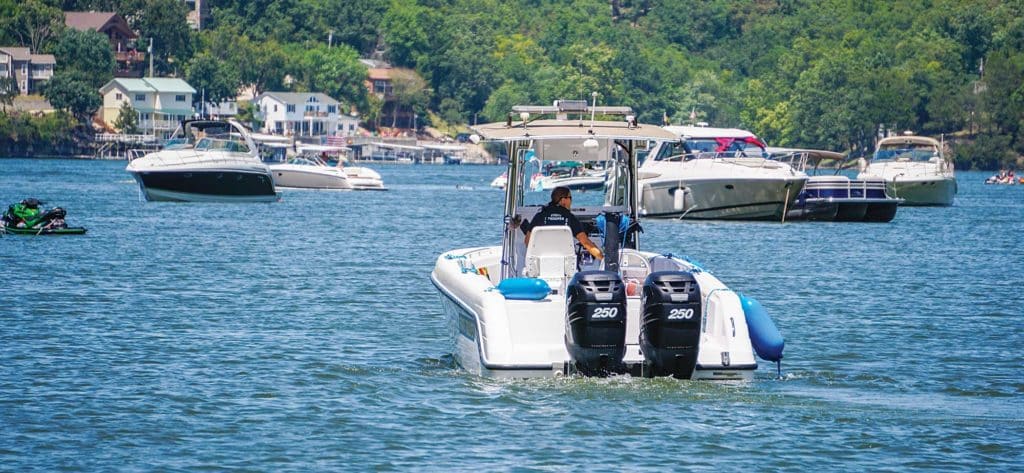
1 P.M.
We arrived at the 1.5-mile-long party spot officially known as Anderson Hollow on maps.
Party Cove was a dirty secret, attractive in its salaciousness of thousands of boaters drinking, dancing, sometimes stripping and, not so rarely, other illegal acts. In its heyday, Party Cove might see over 3,000 boats rafted together with a precision that belied the apparent chaos of so many boats and people in one place.
But, as we rounded the point at the mouth of the cove, it appeared deserted but for a few dozen boats scattered deep in the hollow. In fact, there were multiple rafts of fewer boats, not the endless rafts of rub-rail-to-rub-rail partiers I expected. Along each side of the bay, smaller coves offered one or two boats solitude — an unheard of solitude on Party Cove just a few short years earlier. And there were still some secluded pockets of water available.
Party Cove was no more, and no one who lives at the lake is sad to see its demise. I mused that enforcement was working. Mosher disagreed.
“I wish it was something we did, but it was probably more a change in demographics. People just started spreading out. They go to many different places now,” she explained.
With the cost of marine gasoline (approaching and even exceeding $4 per gallon), perhaps boaters aren’t willing to travel as far to be in the big raft-up. And Anderson Hollow is a good long cruise from many parts of this 92-mile-long waterway. Then there’s that 2-mile-long no-wake zone. There are dozens of coves closer to home port, like Linn Creek Cove at the 31-mile marker or Ha Ha Tonka Cove in the Niangua Arm.
1:15 P.M.
Mosher stopped a pontoon first in Party Cove because three passengers were dragging their feet in the water at the bow — a clearly dangerous practice. They knew it too as they moved back inside the gate. Mosher reminded them of the risk they were taking of falling into the path of the prop.
We learned not everybody is sad to hear from a water trooper as another boat throttled up at a reasonable distance from the rafted boats.
“Pull your ladder up!” Mosher shouted, pointing to the dragging appendage. She repeated the command in a surprisingly booming voice for the thus far soft-spoken trooper. “Pull it up!”
“Thank you! We love you!” they yelled back, blowing kisses as one of the crew secured the ladder, which they would’ve likely lost at sea.
We headed out of Party Cove and back toward Red Bud Cove, where we’d meet up with my boat crew, or so I thought. Halfway there, a pontoon boat was cruising along with two men sitting on the sun pad over the motor. The violation was becoming cliché.
Mosher waved them down and pulled alongside. The boat was a rental from the Fort Leonard Wood Recreation Marina, and its crew were off-duty soldiers. The two on the sun pad clearly didn’t realize why they had been stopped or they would’ve moved.
“It’s real easy to fall off of the sun pad when you’re moving,” said Mosher. They sat down with military precision and she continued, “It’s also illegal.” You could’ve heard a pin drop.
Somebody offered her a cold soda. She declined, but her demeanor went from all-business to fun.
“OK, now, you gotta stay inside the boat. You’ve all got a life jacket, right?” Everybody held one up. Somebody noticed my camera.
“Can you take our picture?”
I complied and took a full group shot, and we exchanged mobile numbers to transfer it.
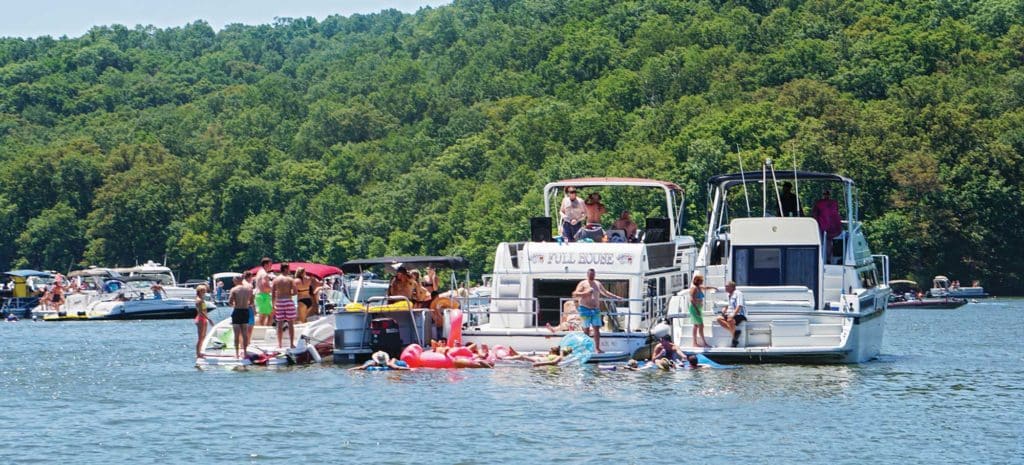
2 P.M.
We still hadn’t written a ticket. Late to the rendezvous with my relatives’ houseboat, I called on the mobile. The location was now Hummingbird Cove, not Red Bud. We were 15 minutes away, and that miscalculation aligned our arrival with the only ticket of the day. I don’t know if the guy was lucky or unlucky.
At the mouth of Hummingbird, we spotted a grandfatherly man idling on a watercraft who, when he spotted us, began shaking his head in dismay. He was pulling two boys on a tube — without a spotter. While we were a couple hundred yards away, she’d watched him pull away from an express cruiser.
“Go on back to your other boat and I’ll meet you there,” she said. He turned, and the next thing I noticed was his jacket wasn’t buckled. Then I spotted a baby dozing between his knees with a loose, ineffective life jacket.
“Sir, you’re taking on a little too much responsibility there,” she said once the watercraft quit rumbling.
“I know. The baby wouldn’t sleep, so we thought the ride would help,” he said as a woman on board took the baby below deck. I could imagine how hard the screaming must’ve been to get him to try the old car-ride trick with the watercraft, and I could also imagine the older boys demanding to go. But he knew Mosher had to write him up, and truthfully, he was lucky we came along before he got farther away from the boat.
I really wanted to take that photograph, but I couldn’t. He was in enough misery. But on any given Saturday on Lake of the Ozarks, stopping an event like that could just save a life. And that’s all the Missouri state troopers want to do.









